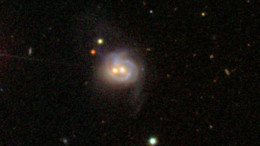Editor’s note: Astrobites is a graduate-student-run organization that digests astrophysical literature for undergraduate students. As part of the partnership between the AAS and astrobites, we occasionally repost astrobites content here at AAS Nova. We hope you enjoy this post from astrobites; the original can be viewed at astrobites.org.
Title: Chandra Observations of Abell 2261 Brightest Cluster Galaxy, a Candidate Host to a Recoiling Black Hole
Authors: K. Gültekin et al.
First Author’s Institution: University of Michigan
Status: Accepted to ApJ
Galaxies can come in many different shapes and sizes, from dwarf galaxies that contain only a few hundred million stars to giant spirals like the Andromeda Galaxy that house over a trillion stars. Their centers can also vary from noisy black holes emitting large jets of radiation (also known as active galactic nuclei) to two spiraling supermassive black holes from two merged galaxies. Today’s paper looks at a bright cluster galaxy and tries to figure out exactly what is at its center.
An Odd Galaxy

Figure 1: Mrk 739, seen here, is an example of a galaxy merger observed before the two supermassive black holes have merged at the center of the newly-formed galaxy. [SDSS]
Astronomers expect that A2261-BCG should host a very massive black hole (which is possibly the result of a merged binary) at the center due to the size of its core. In this paper, the authors look for evidence of a recoiling or ejected black hole in AA2261-BCG, which would indicate that the black hole is a result of a merged binary.
Searching Radio and X-ray Observations
In order to test the theory that this supermassive black hole was once two, the authors focused on four stellar knots, areas of high star density, near the center. If the black hole was recoiling, it would take a clump of stars with it; the black hole would lie at the center of this clump. In previous works, this team used the Very Large Array (VLA) telescope in New Mexico to look for radio emission coming from the stellar knots, but the only activity they found was evidence of old jet activity. They then used the Hubble Space Telescope to look at the stellar velocity distributions of three of the knots to see if there was a massive object around, but didn’t find any conclusive evidence.
In this work, they use X-ray observations taken with the Chandra telescope to look for evidence of accretion onto a large black hole at the center of A2261-BCG. If found, it would point to the fact that the black hole has never recoiled or that the recoil is very slight.
Were They Abell to Figure Out What’s at the Center?
The team analyzed new Chandra observations and performed image and spectral fitting on this data combined with archival data to determine the profile of the gas being emitted from the center. They found evidence of a previous dynamical disturbance, which matches their optical observations, but showed no point-source emission arising from the optical center of the galaxy. The observations show no 1010 solar mass black hole at any of the stellar knots (which is seen in Figure 2 by the absence of any excess emission from the stellar knots), which raises the question of just where the black hole is. One possibility is that it is at the center of the galaxy and is just accreting at such a low rate that it cannot be detected in X-rays. Another possibility is that the black hole traveled farther than 10 kpc away from the center, but looking farther away from the center could increase the chance of more X-ray noise.

Figure 2: Images of the center of the galaxy. Left: the Hubble image showing the four stellar knots in the white contours at the center, with the red circle showing the optical center and the red box showing the location of the radio emission. Middle: Chandra data showing the center. Right: the residuals (the difference between the two). The colors show the amount of X-ray emission. Each panel shows no excess emission at any of the locations. [Gültekin et al. 2020]
While the center should show some evidence for a supermassive black hole, the team finds that either there is no 1010 solar mass black hole at the center, or that it is accreting at a very low level. Further observations with the upcoming James Webb Space Telescope would allow two-dimensional spectral characterization of the core of the galaxy to help determine whether there is a black hole at the center of A2261-BCG.
Original astrobite edited by Brent Shapiro-Albert.
About the author, Haley Wahl:
I’m a third year grad student at West Virginia University and my main research area is pulsars. I’m currently working with the NANOGrav collaboration (a collaboration which is part of a worldwide effort to detect gravitational waves with pulsars) on polarization calibration. In my set of 45 millisecond pulsars, I’m looking at how the rotation measure (how much the light from the star is rotated by the interstellar medium on its way to us) changes over time, which can tell us about the variation of the galactic magnetic field. I’m mainly interested in pulsar emission and the weird things we see pulsars do! In addition to doing research, I’m also a huge fan of running, baking, reading, watching movies, and I LOVE dogs!

